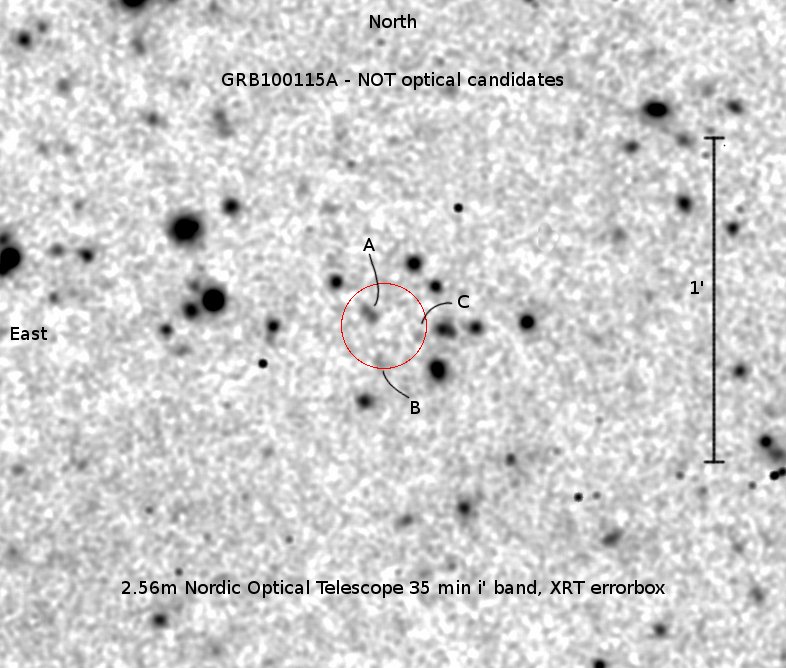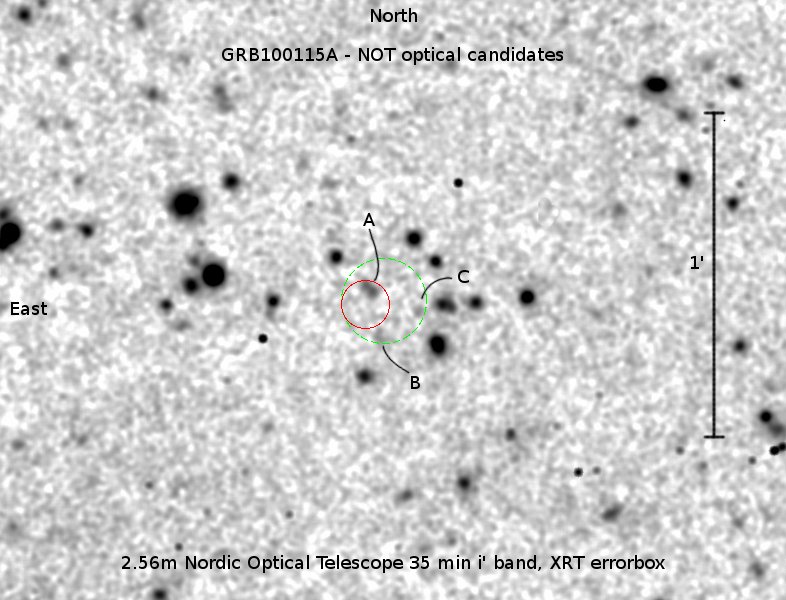- GCN Circular #10325
J. R. Cummings (NASA/GSFC/UMBC), N. Gehrels (NASA/GSFC),
H. A. Krimm (NASA/GSFC/USRA), D. M. Palmer (LANL) report on
behalf of the Swift Team:
At 11:15:19UT, BAT detected GRB 100115A during a preplanned Swift
slew maneuver. A source was found in ground analysis of event data
collected for the BAT Slew Survey at RA, Dec 3.333, -0.817, which is
RA (J2000) 00 13 19.9
Dec (J2000) -00 49 01
with an estimated 90% containment uncertainty of 4 arcmin radius.
The burst was a single FRED pulse with a T90 of about 3 seconds.
There was no detectable flux above 100 keV.
A Swift TOO has been approved.
- GCN Circular #10326
R. Margutti (INAF-OAB), B. Sbarufatti (OAB), J. R. Cummings
(NASA/GSFC/UMBC),
M. De Pasquale (MSSL/UCL) report on behalf of the Swift-XRT team:
Swift began observing the field of the Swift BAT Slew Survey (BATSS)
GRB 100115A (Cummings et al. GCN Circ. 10325) 40ks after the trigger.
Using 2.5 ks of XRT Photon Counting mode data we detect a single
X-ray source source inside the BAT error circle at
RA, DEC= 3.3664, -0.8263 which is equivalent to:
RA (J2000): 00h 13m 27.93s
Dec (J2000): -00d 49' 34.8"
with an uncertainty of 6.8 arcsec (radius, 90% confidence).
The source is detected at a level of 6.6x10^-3 count sec^-1.
Given the current statistics it is not possible to determine whether
this source is fading.
A tentative spectrum formed from the PC mode data can be fitted with
an absorbed power-law with a photon spectral index of 2.7 (+1.7, -0.8). The
best-fitting absorption column is consistent with the Galactic value
of 3.1 x 10^20 cm-2 (Kalberla et al. 2005). The counts to observed
(unabsorbed) 0.3-10 keV flux conversion factor deduced from this
spectrum is 2.9 x 10^-11 (3.6 x 10^-11) erg cm^-2 count^-1.
The results of the XRT-team automatic analysis are available at
http://www.swift.ac.uk/xrt_products/00020126.
This circular is an official product of the Swift-XRT team.
- GCN Circular #10327
S. R. Oates (MSSL-UCL) reports on behalf of the Swift/UVOT team:
The Swift/UVOT began observerving the field of Swift BAT Slew
Survey (BATSS) GRB 100115A (Cummings et al. GCN Circ. 10325) 40ks
after the BAT trigger. We do not detect any source at the candidate
Swift XRT position (Margutti et al. GCN Circ. 10326).
The 3 sigma upper limits for the summed images are reported below:
Filter T_start(s) T_stop(s) Exposure Mag(3 sgma UL)
###########################################################
b 40636 46609 411 >20.19
u 40423 46395 411 >19.85
uvw1 40001 46180 824 >20.29
uvw2 40849 47260 1098 >20.99
###########################################################
The above magnitudes are not corrected for the Galactic extinction
corresponding to a reddening of E_{B-V} = 0.06 mag (Schlegel et al.,
1998, ApJS, 500, 525). The photometry is on the UVOT photometric system
described in Poole et al. (2008, MNRAS, 383,627).
- GCN Circular #10328
Adria C. Updike, Dieter H. Hartmann (Clemson University) and Robert
Berrington (Ball State University) report:
We observed the field of the Swift-detected GRB 100115A (Cummings et al.,
GCN 10325) with the 0.9m SARA telescope located at Kitt Peak National
Observatory beginning 15 hours and 20 minutes after the BAT detection
under good conditions. In a single 1200 sec exposure, we detect a source
within the XRT error circle (Margutti et al., GCN 10326) around R ~ 22 mag
(as compared to USNO B.1 catalog field stars). There is no corresponding
counterpart in either SDSS or Sloan. The Sloan survey goes deeper than
our image, indicating the new source in the XRT error circle is a
potential candidate for the afterglow of GRB 100115A. No statement about
variability can be made at this time; further observations are encouraged.
- GCN Circular #10329
Martin Jelinek (IAA CSIC Granada), Petr Kubanek (IPL Valencia)
and Javier Gorosabel, Antonio J. Delgado (IAA CSIC) on behalf
of a larger colaboration.
report:
We observed the Swift-XRT errorbox of the GRB100115A (Margutti
et al. GCN 10326) with the 2.56 Nordic Optical Telescope at La
Palma. We acquired 7x 300s i' band exposure at about 32 hours
after the GRB. The detection limit of this image is about i' =
24.0 mag.
We detect four sources within or at the border of the X-ray
errorbox. None of these objects is present in the SDSS DR7
image, with the exception of A, which could be believed to be
at the its very detection limit. This object also seems in our
image extended and/or composed of two components.
Given the lack of astrometric information in the Updike et al.
(GCN 10328) we cannot confirm or decide whether one of these
objects is an optical afterglow of GRB100115A. We however do
not see any object as bright as previously reported, which
might confirm the decaying behaviour of the afterglow
candidate by SARA.
The identification card with the objects marked A, B and C
can be downloaded from
http://www.iaa.es/mates/grb100115a-not-errorbox.jpg
This message may be cited.

- GCN Circular #10331
Martin Jelinek (IAA CSIC Granada), Petr Kubanek (IPL Valencia)
and Javier Gorosabel, Antonio J. Delgado (IAA CSIC) on behalf
of a larger colaboration.
report:
In light of the new XRT improved position we reexamined the
NOT image from our previous report (Jelinek et al., GCN 10329)
and found that only the (extended) object A at
00:13:28.12 -00:49:32.6 +-2" (J2000)
stays within the XRT errorbox and may be possibly related to
the GRB100115A, either as its afterglow, host galaxy or a
combination of both.
The improved identification card can be downloaded from
http://www.iaa.es/~mates/grb100115a-not-errorbox2.jpg
We thank Alex Kann for pointing out the new XRT position.
This message may be cited.

- GCN Circular #10332
D. Alexander Kann (TLS Tautenburg), Adria C. Updike and Dieter H. Hartmann
(Clemson University) report:
We performed astrometry (against the USNO-B1.0 catalog) on the image of
the field of GRB 100115A (Cummings et al., GCN 10325) taken by the 0.9m
SARA observatory at KPNO, which revealed a possible afterglow candidate
(Updike et al., GCN 10328).
For this object, we derive a position of (conservative error 1"):
RA (J2000): 00:13:28.05
Dec. (J2000): -00:49:32.4
in full agreement with the position given for Object "A" by Jelinek et al.
(GCN 10331), and possibly closer to (or identical with) the brighter
southwest component of Object "A".
Given the lack of photometric information in Jelinek et al. (GCN 10331) we
cannot confirm if the SARA candidate has faded significantly, but note
that, in the SARA image, the afterglow candidate is about as bright as the
star to the southwest at RA (J2000): 00:13:27.20, Dec. (J2000): -00:49:42.4, and it
seems to be much fainter than this source (note the different filters,
though) in the Jelinek finding chart.
This message may be cited.
- GCN Circular #10334
R. Margutti (INAF-OAB), P.A. Evans and M.R. Goad (U. Leicester) report
on behalf of the Swift-XRT team:
Using 1321 s of XRT Photon Counting mode data and 1 UVOT
images, we find an astrometrically corrected X-ray position (using the
XRT-UVOT alignment and matching UVOT field sources to the USNO-B1
catalogue): RA, Dec =3.36730, -0.82650 which is equivalent to:
RA (J2000): 00 13 28.16
Dec (J2000): -00 49 35.4
with an uncertainty of 4.0 arcsec (radius, 90% confidence).
This position may be improved as more data are received. The latest
position can be viewed at http://www.swift.ac.uk/xrt_positions. Position
enhancement is described by Goad et al. (2007, A&A, 476, 1401) and Evans
et al. (2009, MNRAS, 397, 1177).
This circular is an official product of the Swift-XRT team.
- GCN Circular #10335
A. Cucchiara, D. B. Fox (PennState), E. Berger (Harvard U.)
report on behalf of a larger collaboration:
"On January 16.20 UT we observed the field of GRB100115A
(Cummings et al. 10325, Margutti et al. GCN 10326) with the
Gemini-North GMOS camera in r and g bands.
We collected a sequence of 5x180s images in each filter.
In the coadded images the afterglow candidate is visible in
both filters (GCN 10328,10331,10332).
On January 17.20 UT we collected a second epoch with the same set-up.
The following magnitude have been calibrated using the USNO-B1.0
star at RA: 00:13:30.44 Dec: -00:49:16.93 ( = 19.76 mag):
Jan. 16.20 UT:
r = 21.37 +- 0.08 mag
Jan 17.20 UT:
r = 21.86 +- 0.08 mag
A similar fading of ~0.5 mag is present in our g-band observations.
Therefore we conclude that Object "A", which shows two structures,
contains a fading transient. Further observation are planned.
We thank the Gemini staff, in particular Sandy Leggtt, for performing these
observations.
- GCN Circular #10352
R. Margutti, B. Sbarufatti (INAF-OAB), S. Oates (MSSL/UCL),
report on behalf of the Swift-XRT team:
The Swift ToO observations of the BATSS burst GRB 100115A
(Cummings et al., GCN Circ. 10325) started 40ks after the
trigger. The XRT data set consists of 8 ks exposure in PC mode
split into two epochs: the first observation was performed
at T0+40 ks, while a second epoch of observations was acquired
at T0+306 ks. The UVOT-enhanced XRT position was given by
Margutti et al. in GCN Circ. 10334.
In the second observation the X-ray source reported by Margutti
et al., GCN Circ.10326 has faded to a level of (1.4 +/- 0.9)e-3
count/sec corresponding to a decay index of -0.7 +/- 0.4.
This source is likely to be the afterglow of GRB 100115A.
No further observations are planned.
A spectrum formed from the PC mode data can be fitted with an absorbed
power-law with a photon spectral index of 2.0 (+1.0, -0.5). The
best-fitting absorption column is consistent with the Galactic value
of 3.1 x 10^20 cm^-2 (Kalberla et al. 2005). The counts to observed
(unabsorbed) 0.3-10 keV flux conversion factor deduced from this spectrum
is 3.4 x 10^-11 (3.8 x 10^-11) erg cm^-2 count^-1.
The results of the XRT-team automatic analysis are available at
http://www.swift.ac.uk/xrt_products/00020126.
This circular is an official product of the Swift-XRT team.
- GCN Report 264.1
GCN_Report 264.1 has been posted:
http://gcn.gsfc.nasa.gov/reports/report_264_1.pdf
by S.R. Oates
at Mssl-UCL
titled: "Final Swift Observations on GRB 100115A"
![]() Previous IAU Circulars
Previous IAU Circulars 
